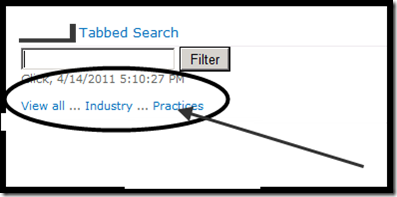I have been doing a lot of of XSLT and jQuery and thought I’d share a few snippets that others may find useful in future.
Example 1: Emit simple JavaScript / jQuery in XSLT:
<xsl:template match="something" xml:space="preserve">
<!– Blank out the query friendly filters hidden field –>
<script type="text/javascript">
$(document).ready(function(){
$("#QueryFriendlyFilters").val("empty");
});
</script></xsl:template>
That bit emits some JavaScript that waits for the page to finish loading (because of the $(document).ready(…)) and then sets the value of a hidden field named QueryFriendlyFilters to the literal value “empty”.
Example 2: Use <xsl:if> to check “greater than”, “less than”, etc.
<xsl:template match="something" xml:space="preserve">
<div id="fdcAllFilters">
<xsl:if test="@Count>0">
<span class="fdcFilterLabel">Current filters:</span>
</xsl:if><!– more stuff happens here. –>
</xsl:template>
The above snippet checks to see if an attribute named “Count” of the “something” element is greater than zero. The XML behind this would be something like:”
<something Count=”5” />
Example 3: Iterate through all elements, interspersing jQuery calls.
<!– Iterate through all the filters and display the correct links. –>
<xsl:for-each select="UserFilter"><a class="FilterHref" href="javascript:mySubmitPage(‘RemoveUserFilter’,'{@ID}’)">[X]</a>
<span class="fdcFilterLabel"><xsl:value-of select="@FilterValue"/></span>
<script type="text/javascript">$(document).ready(function(){
<xsl:text><![CDATA[$("#QueryFriendlyFilters").val( ($("#QueryFriendlyFilters").val() + " ]]></xsl:text>\"<xsl:value-of select="@FilterValue"/>\"<xsl:text><![CDATA["));]]></xsl:text>
});</script>
</xsl:for-each>
The above snippet is the most complex and there may be easier ways to do it.
The XML behind this looks roughly like this:
<UserFilter ID=”123” FilterValue=”xyzzy” />
This snippet is iterating through <UserFilter> nodes.
It first emits an anchor tag that when clicked invokes a JavaScript function that is already on the page, “mySubmitPage” and passes the value of an attribute on the <UserFilter> node named “ID”.
It then emits some jQuery that waits for the page to load. That jQuery updates a hidden field named “QueryFriendlyFilters” by adding the value of the FilterValue attribute. Note all the crazy <xsl:text> and <![CDATA[ … ]]> stuff.
That’s it, hope it helps!
</end>
Follow me on Twitter at http://www.twitter.com/pagalvin

